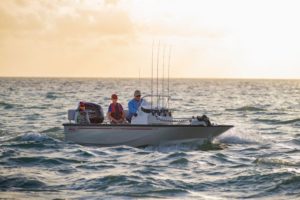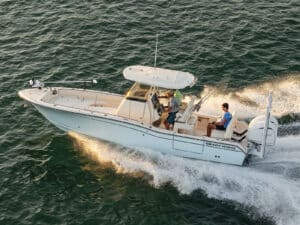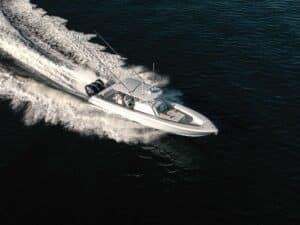
Joe Albanese grew up on New York’s Long Island, fishing and clamming in the salt marshes and along open beaches. During his career in conservation, he piloted a variety of vessels through ice fields and along waterways from Alaska to metropolitan New York. But when it comes to chasing stripers, he has developed some distinct preferences over the years.
Boat Type
“I prefer center-consoles for my striper fishing, with the open layout lending itself to a variety of fishing techniques. From fly-fishing to light tackle to live bait, it can do it all. Unless you’re going to stick to the marshes, consider an 18-footer as the bare minimum. And if your commute involves an inlet that can get snotty, a 22-footer is better. But if you want to take advantage of the inshore tuna bite that has developed in the Northeast in recent years, look at the crop of capable 25-plus-footers that can run out to the 3-mile line and beyond.”
Motors
“I tend to be pretty heavy-handed with the throttle, so I like as much horsepower as I can get. I start my season early and go right through the end, so the ability to outrun weather is important to me. Even if you don’t feel the need for speed, having the most horsepower a hull is rated for will let you cruise at a lower rpm, which should provide some fuel savings.”
On Draft
“However big a boat you choose, you need to consider its draft. If you want to play in the creeks and flats, you need a boat that draws 15 inches or less. But even a heavy 22-footer will still draft less than 16 inches, which should get you just about anywhere that stripers swim. If you plan on spending more time in the ocean than in the bays, you might want to select a hull with more transom deadrise, around 20 degrees or more. You’ll lose some of the shallow-water capabilities, but you’ll be able to cut through waves and chop better.”
Trolling Motors
“In my opinion, there’s no better way to work the creeks than with the aid of a trolling motor. You can come off plane far from where you plan on fishing, and use the trolling motor to sneak into position, getting back into places that you probably couldn’t with your outboard. Trolling motors also excel for probing dock lines, letting you plod along without disturbing fish. Plus, the virtual-anchor feature available on most models lets you easily work a piece of structure or pinch point like a bridge.”
Livewells
“As primarily a fly and light-tackle angler, I don’t need a ton of live-bait capacity. That said, it’s hard to beat the excitement of live-lining bunker for the outsize stripers that have become so common in recent years. My Robalo has a well-designed 15-gallon livewell that can keep eight menhaden lively throughout the day, but if you are a dedicated live-baiter, you might want something with a greater capacity.”
Electronics
“I still find many of my spots using land ranges, but it’s hard to beat the navigation and fish-finding capabilities of today’s electronics. I have a Garmin multifunction display on my helm, which allows me to access a variety of maps and navigation tools via the touchscreen interface. I can also choose from a couple of different sonar frequencies that give me a clear picture of the bottom in depths from single to triple digits.”
Rod Holders
“I tend to head out with fewer sticks than most, but when you put a couple of people on board, rod holders disappear quickly. I like undergunwale storage to keep rods out of the way, particularly fly rods. I keep most of the other rods clustered in vertical holders on the sides of the console, but having a few on the back of the helm seating provides a good place to stash a rod in a hurry. A few gunwale rod holders are useful for dead-sticking and the like.”









